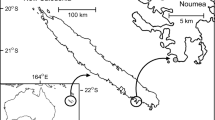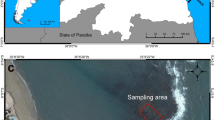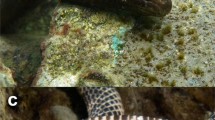Summary
Three adult size classes of the territorial Caribbean dusky damselfish,Stegastes dorsopunicans, are differently distributed with respect to habitat, and with respect to the biomass of filamentous algal turfs in the areas they defend. The density of large individuals is positively correlated with the decalcified dry biomass of these turfs, whereas the densities of medium and small individuals are inversely related to algal biomass. Density of the urchin,Diadema, is also inversely correlated with algal biomass. The high density of large dusky damselfish in sites with algal turfs of relatively high biomass probably results from preferences of dusky damselfish for sites in which algal turfs are thick, and superior abilities of large individuals to defend these sites.
Because both rate of attacks and the effectiveness of attacks on territory invaders by dusky damselfish increases with increasing size, sites with relatively high biomass algal turfs are typically better defended than those with lower biomass turfs. Apparently as a result of this, small foraging groups of the blue tang surgeonfish,Acanthurus coeruleus, feed less on high biomass algal turfs than do larger foraging groups, the members of which experience attacks by defending damselfishes less frequently. The relatively low proportionate use of high biomass feeding sites by solitary blue tangs and members of small foraging groups is caused by dusky damselfish. When the density of this damselfish was reduced artificially, use of high biomass algal turfs by solitary blue tangs increased to a level indistinguishable from that of participants in large foraging groups.
Similar content being viewed by others
References
Alevizon WS (1976) Mixed schooling and its possible significance in a tropical western atlantic parrotfish and surgeonfish. Copeia 1978:796–798
Bak RPM, Carpay MJE, de Ruyter van Steveninck ED (1984) Densities of the sea urchinDiadema antillarum before and after mass mortalities on the coral reefs of Curaçao. Mar Ecol Progr Ser 17:105–108
Barlow GW (1974) Extraspecific imposition of social grouping among surgeonfishes (Pisces: Acanthuridae). J Zool Soc London 174:333–340
Ebersole JP (1977) The adaptive significance of interspecific territoriality in the reef fishEupomacentrus leucosticus. Ecology 58:914–920
Estes RD, Goddard J (1967) Prey selection and hunting behavior of the African wild dog. J Wildlife Management 31:52–70
Foster SA (1984) Ecological consequences and evolutionary implications of group foraging by coral reef fishes. Ph.D. Dissertation University of Washington, Seattle, Washington
Foster SA (1985) Group foraging by a coral reef fish: A mechanism for gaining access to defended resources. Anim Behav (in press)
Hobson ES (1968) Predatory behavior of some shore fishes in the Gulf of California. Bur Sport Fish and Wildlife, Res Rep 73:1–92
Itzkowitz M (1977) Spatial organization of the Jamaican damsel-fish community. J Exp Mar Biol Ecol 28:217–241
Jones RS (1968) Ecological relationships in Hawaiian and Johnston Island Acanthuridae (Surgeonfishes). Micronesica 4:309–361
Kruuk H (1972) The spotted hyena: a study of predation and social behavior. University of Chicago Press, Chicago, USA
Kynard BE (1979) Breeding behavior of a lacustrine population of threespine sticklebacks (Gasterosteus aculeatus L.). Behav 67:178–207
Lessios HA, Robertson DR, Cubit JD (1984) Spread ofDiadema mass mortality through the Caribbean. Science 226:335–337
Lessios HA, Cubit JD, Robertson DR, Shulman MJ, Parker MR, Garrity SD, Levings SC (1985) Mass mortality ofDiadema antillarum on the Caribbean Coast of Panama. Coral Reefs 3:173–182
Lobel PS (1980) Herbivory by damselfishes and their role in coral reef community ecology. Bull Mar Sci 30:273–289
Low RM (1971) Interspecific territoriality in a pomacentrid reef fish,Pomacentrus flavicauda Whitley. Ecology 52:648–654
Mahoney BM (1981) An examination of interspecific territoriality in the dusky damselfish,Eupomacentrus dorsopunicans Poey. Bull of Mar Sci 31:141–146
Mech LD (1970) The wolf: the ecology of an endangered species. Natural History Press, Garden City, New Jersey, USA
Montgomery WL, Gerrodette T, Marshall LD (1980) Response of algal communities to grazing by the yellowtail surgeonfish,Prionurus punctatus in the Gulf of California, Mexico. Bull Mar Sci 30:477–481
Murie A (1944) The wolves of Mount McKinley. Fauna of the National Parks of the United States, Fauna Series no. 5. U.S. Department of the Interior, Washington, DC, USA
Ogden JC, Buckman NS (1973) Movements, foraging groups, and diurnal migrations of the striped parrotfishScarus croicensis Block (Scaridae). Ecology 54:589–596
Randall JE (1967) Food habits of reef fishes of the West Indies. Stud Trop Oceanogr 5:665–847
Randall JE (1968) Caribbean Reef Fishes. T.F.H. Publications, Neptune City, New Jersey, USA
Robertson DR (1984) Conabitation of competing territorial damselfishes on a Caribbean coral reef. Ecology 65:1121–1135
Robertson DR, Hoffman SG, Sheldon JM (1981) — Availability of space for the territorial Caribbean damselfishEupomacentrus planifrons. Ecology 62:1162–1169
Robertson DR, Lassig B (1980) Spatial distribution patterns and coexistence of a group of territorial damselfishes from the Great Barrier Reef. Bull Mar Sci 30:187–203
Robertson DR, Polunin CV (1981) Coexistence: symbiotic sharing of feeding territories and algal food by some coral reef fishes from the Western Indian Ocean. Mar Biol 62:185–195
Robertson DR, Polunin NVC, Leighton K (1979) The behavioral ecology of three Indian Ocean Surgeonfishes (Acanthurus lineatus, A. leucosternon, andZebrasoma scopas): their feeding strategies, and social and mating systems. Environ Biol Fish 4:125–170
Robertson DR, Sweatman HPA, Fletcher EA, Cleland MG (1976) Schooling as a mechanism for circumventing the territoriality of competitors. Ecology 57:1208–1220
Sammarco PW, Williams AH (1982) Damselfish territoriality: Influence onDiadema distribution and implications for coral community structure. Mar Ecol Prog Ser 8:53–59
Schaller GB (1972) The Serengeti lion: a study of predator-prey relations. University of Chicago Press, Chicago, USA
Vine PJ (1974) Effects of algal grazing and aggressive behavior of the fishesPomacentrus lividus andAcanthurus sohal on coral reef ecology. Mar Biol 24:131–146
Waldner RE, Robertson DR (1980) Patterns of habitat partitioning by eight species of territorial Caribbean damselfishes (Pisces: Pomacentridae). Bull Mar Sci 30:171–186
Williams AH (1981) An analysis of competitive interactions in a patchy backreef environment. Ecology 62:1107–1120
Author information
Authors and Affiliations
Rights and permissions
About this article
Cite this article
Foster, S.A. Size-dependent territory defense by a damselfish. Oecologia 67, 499–505 (1985). https://doi.org/10.1007/BF00790020
Received:
Issue Date:
DOI: https://doi.org/10.1007/BF00790020




